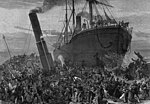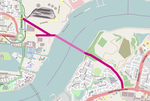River Roding
England river stubsEpping Forest DistrictEssex geography stubsGeography of the London Borough of Barking and DagenhamGeography of the London Borough of Newham ... and 6 more
Geography of the London Borough of RedbridgeLondon geography stubsRivers of EssexRivers of LondonThames drainage basinUse British English from September 2017

The River Roding () rises at Molehill Green, Essex, England, then flows south through Essex and London and forms Barking Creek as it reaches the River Thames.
Excerpt from the Wikipedia article River Roding (License: CC BY-SA 3.0, Authors, Images).River Roding
River Road, London Barking Riverside (London Borough of Barking and Dagenham)
Geographical coordinates (GPS) Address Nearby Places Show on map
Geographical coordinates (GPS)
| Latitude | Longitude |
|---|---|
| N 51.5142 ° | E 0.0993 ° |
Address
Docklands Wharf
River Road
IG11 0DS London, Barking Riverside (London Borough of Barking and Dagenham)
England, United Kingdom
Open on Google Maps








